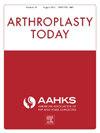以 Vanguard XP 为例,早期识别密歇根州性能不佳的植入体
IF 1.5
Q3 ORTHOPEDICS
引用次数: 0
摘要
背景关节成形术注册机构在提高医疗质量和对医疗器械进行上市后监测方面发挥着至关重要的作用。我们报告了密歇根关节成形术注册协作质量倡议(MARCQI)针对Biomet Vanguard XP双椎体固位全膝关节植入物的调查结果。方法从MARCQI的2019年报告(2012年2月15日至2018年12月31日)中收集数据。对人口统计学数据进行了分析,以确定 Vanguard XP 与所有其他植入物之间的差异。根据存活函数 S(t),计算出累积修正百分比 (CPR),即 CPR(t) = 100∗(1-S(t))。结果MARCQI登记处共有148832例膝关节置换术病例,其中507例使用了Vanguard XP植入物组合。Vanguard XP术后5年的未调整累积翻修率曲线与所有其他假体不同(P < .0001)。Cox比例危险模型中包含的三个因素的危险比均与统一值有显著差异:种植体(2.76,95% CI:1.98-3.86)、性别(0.80,95% CI:0.74-0.85)和年龄(0.96,95% CI:0.96-0.97)。翻修的前三位原因分别是疼痛、关节纤维化和无菌性松动。结论在 MARCQI 登记中,Vanguard XP 的早期失败率高于其他 TKA 植入物。与业界合作制定登记报告的阈值和基准可能会使患者免于因植入物性能不如预期而导致的发病率。本文章由计算机程序翻译,如有差异,请以英文原文为准。
Early Identification of Poorly Performing Implants in Michigan With the Example of the Vanguard XP
Background
Arthroplasty registries play a critical role in improving the quality of care and performing post-market surveillance of medical devices. We report the Michigan Arthroplasty Registry Collaborative Quality Initiative (MARCQI) findings specific to the Biomet Vanguard XP bicruciate-retaining total knee implant.
Methods
Data were collected from MARCQI’s 2019 report (February 15, 2012, through December 31, 2018). Demographic data were analyzed to determine differences between Vanguard XP and all other implants. The cumulative percent revision (CPR) was computed from the survival function, S(t), using CPR(t) = 100∗(1 − S(t)). A log-rank test was used to assess differences in the CPR curve for the Vanguard XP and all other implants.
Results
There were 148,832 knee arthroplasty cases in the MARCQI registry and 507 using Vanguard XP implant combinations. The unadjusted cumulative percent revision curve up to 5 years postoperatively for the Vanguard XP differed from all other implants (P < .0001). The hazard ratios for the 3 factors included in the Cox proportional hazards model were all significantly different from unity: implant (2.76, 95% CI: 1.98-3.86), sex (0.80, 95% CI: 0.74-0.85), and age (0.96, 95% CI: 0.96-0.97). The top 3 reasons for revision were pain, arthrofibrosis, and aseptic loosening. All surgeons who used the Vanguard XP experienced higher failure rates.
Conclusions
The Vanguard XP experienced higher early failure rates than other TKA implants within the MARCQI registry. The development of thresholds and benchmarks for registry reporting in collaboration with industry could potentially save patients from the morbidity caused by implants that do not perform as well as anticipated.
求助全文
通过发布文献求助,成功后即可免费获取论文全文。
去求助
来源期刊

Arthroplasty Today
Medicine-Surgery
CiteScore
2.90
自引率
0.00%
发文量
258
审稿时长
40 weeks
期刊介绍:
Arthroplasty Today is a companion journal to the Journal of Arthroplasty. The journal Arthroplasty Today brings together the clinical and scientific foundations for joint replacement of the hip and knee in an open-access, online format. Arthroplasty Today solicits manuscripts of the highest quality from all areas of scientific endeavor that relate to joint replacement or the treatment of its complications, including those dealing with patient outcomes, economic and policy issues, prosthetic design, biomechanics, biomaterials, and biologic response to arthroplasty. The journal focuses on case reports. It is the purpose of Arthroplasty Today to present material to practicing orthopaedic surgeons that will keep them abreast of developments in the field, prove useful in the care of patients, and aid in understanding the scientific foundation of this subspecialty area of joint replacement. The international members of the Editorial Board provide a worldwide perspective for the journal''s area of interest. Their participation ensures that each issue of Arthroplasty Today provides the reader with timely, peer-reviewed articles of the highest quality.
 求助内容:
求助内容: 应助结果提醒方式:
应助结果提醒方式:


